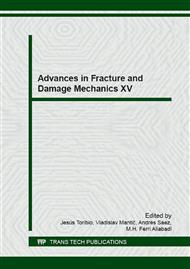[1]
M. Kanninen, An augmented double cantilever beam model for studying crack propagation and arrest, Int. J. Fract., vol. 9, no. 1, p.83–92, (1973).
DOI: 10.1007/bf00035958
Google Scholar
[2]
L. A. Carlsson, J. W. Gillespie, and R. B. Pipes, On the Analysis and Design of the End Notched Flexure (ENF) Specimen for Mode II Testing, J. Compos. Mater., vol. 20, p.594–604, Jan. (1986).
DOI: 10.1177/002199838602000606
Google Scholar
[3]
ASTM D6671, Standard Test Method for Mixed Mode I-Mode II Interlaminar Fracture Toughness of Unidirectional Fiber Reinforced Polymer Matrix Composites, (2010).
DOI: 10.1520/d6671_d6671m
Google Scholar
[4]
J. Viguié, P. Latil, L. Orgéas, P. J. J. Dumont, S. Rolland du Roscoat, J. -F. Bloch, C. Marulier, and O. Guiraud, Finding fibres and their contacts within 3D images of disordered fibrous media, Compos. Sci. Technol., vol. 89, p.202–210, Dec. (2013).
DOI: 10.1016/j.compscitech.2013.09.023
Google Scholar
[5]
H. A. Richard and K . Benitz, A loading device for the creation of mixed mode in fracture mechanics, Int. J. Fract., vol. 22, p.55–58, (1983).
DOI: 10.1007/bf00942726
Google Scholar
[6]
R. Rikards, F. -G. Buchholz, H. Wang, a. K. Bledzki, a. Korjakin, and H. -a. Richard, Investigation of mixed mode I/II interlaminar fracture toughness of laminated composites by using a CTS type specimen, Eng. Fract. Mech., vol. 61, no. 3–4, p.325–342, Sep. (1998).
DOI: 10.1016/s0013-7944(98)00068-x
Google Scholar
[7]
L. Hoffmann, T. P. Yu, and S. S. Wang, Fracture of knitted randomly oriented short-fiber composite, Int. J. Fract., vol. 74, no. 4, p.363–381, (1996).
DOI: 10.1007/bf00035848
Google Scholar
[8]
V. Li, Y. Wang, and S. Backers, A Micromechanical Model Of Tension- Softening And Bridging Toughening Of Short Random Fiber Reinforced Brittle Matrix Composites, J. Mech. Phys. solids, vol. 39, no. 5, p.607–625, (1991).
DOI: 10.1016/0022-5096(91)90043-n
Google Scholar
[9]
J. Jamali and J. T. Wood, Mixed-mode through-thickness fracture of polymer matrix composites, in 19th International conference on composite materials (ICCM 19), Montreal, Canada, 2013, no. 2, p.6453–6462.
Google Scholar
[10]
J. Jamali, Mechanistic Failure Criterion for Unidirectional and Random Fibre Polymer Composites, PhD thesis, Mechanical and Materials Engineering department, The University of Western Ontario, London, Ontario, Canada, http: /ir. lib. uwo. ca/etd/2185, (2014).
Google Scholar
[11]
J. Jamali, Y. Fan, and J. T. Wood, The Mixed-Mode Fracture Behaviour of Epoxy By The Compact Tension Shear Test, Int. J. Adhes. Adhes., vol. 63, p.79–86, Aug. (2015).
DOI: 10.1016/j.ijadhadh.2015.08.006
Google Scholar
[12]
J. Jamali, A. -H. I. Mourad, Y. Fan, and J. T. Wood, Through-thickness fracture behavior of unidirectional glass fibers/epoxy composites under various in-plane loading using the CTS test, Eng. Fract. Mech., vol. 156, p.83–95, Jan. (2016).
DOI: 10.1016/j.engfracmech.2016.01.016
Google Scholar
[13]
American Society for testing and materials, Standard Test Method for Ignition Loss of Cured Reinforced Resins, ASTM D2584-08, p.1–3, (2010).
Google Scholar
[14]
H. Richard, Some theoretical and experimental aspects of mixed mode fractures, Adv. Fract. Res., p.3337–3344, (1984).
DOI: 10.1016/b978-1-4832-8440-8.50358-6
Google Scholar
[15]
T. P. Bruce, Mechanistic Mixed-Mode Failure Criterion For Continuous Fiber-Polymer Composites. PhD thesis, Mechanical and Materials Engineering Department Western University, Canada, (2011).
Google Scholar
[16]
J. Jamali and J. Wood, Mixed- mode testing of polymer matrix composites, in 24th Canadian Materials Science Conference, UWO, London, Ontario, (2012).
Google Scholar
[17]
J. Jamali, Y. Fan, and J. T. Wood, Fracture Of Random Fibre Polymer Composites, in Proceedings of The Canadian Society for Mechanical Engineering International Congress (CSME), Toronto, Canada, (2014).
Google Scholar


